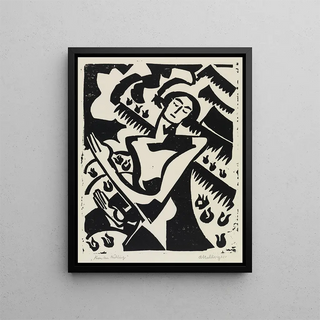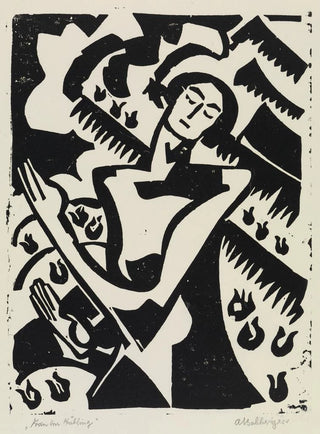Art print | Woman in Spring - August Babberger


View from behind

Frame (optional)
August Babberger's artwork "Femme au printemps" delicately and subtly evokes the fleeting beauty of nature and feminine grace. In this canvas, the artist manages to capture the very essence of spring, a season synonymous with renewal and vitality. The depicted woman, amidst a lush garden, seems to embody this flowering period, where every petal and blade of grass vibrates with new energy. This piece, both poetic and immersive, transports the viewer into a universe where natural beauty and sensuality blend harmoniously. The soft light and pastel colors enhance this dreamy atmosphere, inviting everyone to a soothing contemplation.
Style and uniqueness of the artwork
August Babberger's style is distinguished by its impressionist approach, where light plays a predominant role. In "Femme au printemps," fluid and light brushstrokes convey a sense of movement, as if the wind caresses the protagonist's hair. The pastel tones, ranging from tender green to delicate pink, create a soft and harmonious palette. This work also stands out through its composition, where the female figure is beautifully integrated into her floral environment. Babberger uses organic shapes and sinuous lines to evoke the connection between woman and nature, thus highlighting a romantic vision of femininity. Every detail, from flowers to leaves, is treated with meticulous care that reflects the artist's love for his subject.
The artist and his influence
August Babberger, though less known than some of his contemporaries, managed to leave his mark on his era with a unique style and remarkable artistic sensitivity. Born at the end of the 19th century, he was influenced by the great masters of Impressionism but also developed his own voice, blending tradition and innovation. His work is often characterized by an exploration of themes of nature and femininity, demonstrating a deep admiration for the beauty of the world around him. Babberger captured moments of grace and serenity, making his canvases visual refuges where the viewer can escape. His influence, though discreet,

Matte finish

View from behind

Frame (optional)
August Babberger's artwork "Femme au printemps" delicately and subtly evokes the fleeting beauty of nature and feminine grace. In this canvas, the artist manages to capture the very essence of spring, a season synonymous with renewal and vitality. The depicted woman, amidst a lush garden, seems to embody this flowering period, where every petal and blade of grass vibrates with new energy. This piece, both poetic and immersive, transports the viewer into a universe where natural beauty and sensuality blend harmoniously. The soft light and pastel colors enhance this dreamy atmosphere, inviting everyone to a soothing contemplation.
Style and uniqueness of the artwork
August Babberger's style is distinguished by its impressionist approach, where light plays a predominant role. In "Femme au printemps," fluid and light brushstrokes convey a sense of movement, as if the wind caresses the protagonist's hair. The pastel tones, ranging from tender green to delicate pink, create a soft and harmonious palette. This work also stands out through its composition, where the female figure is beautifully integrated into her floral environment. Babberger uses organic shapes and sinuous lines to evoke the connection between woman and nature, thus highlighting a romantic vision of femininity. Every detail, from flowers to leaves, is treated with meticulous care that reflects the artist's love for his subject.
The artist and his influence
August Babberger, though less known than some of his contemporaries, managed to leave his mark on his era with a unique style and remarkable artistic sensitivity. Born at the end of the 19th century, he was influenced by the great masters of Impressionism but also developed his own voice, blending tradition and innovation. His work is often characterized by an exploration of themes of nature and femininity, demonstrating a deep admiration for the beauty of the world around him. Babberger captured moments of grace and serenity, making his canvases visual refuges where the viewer can escape. His influence, though discreet,






